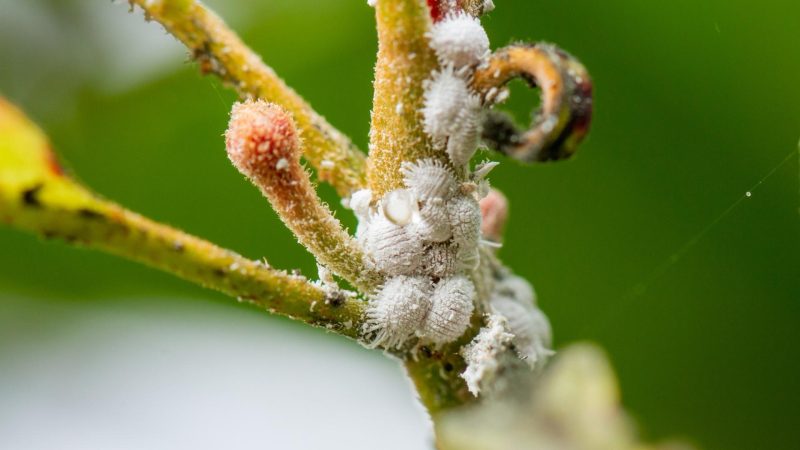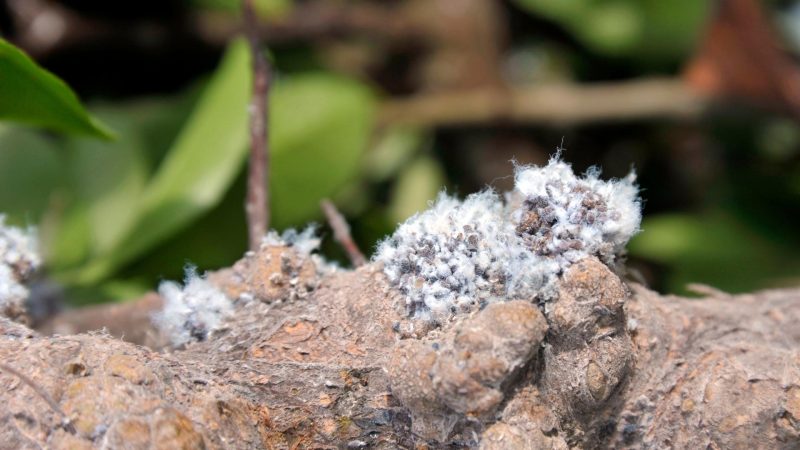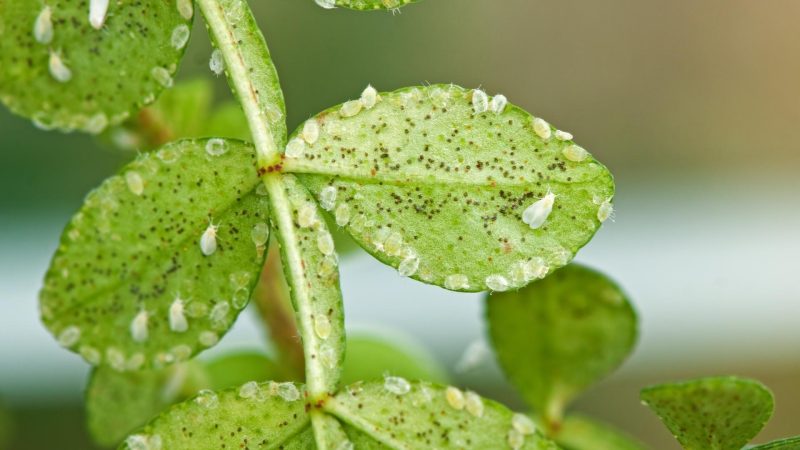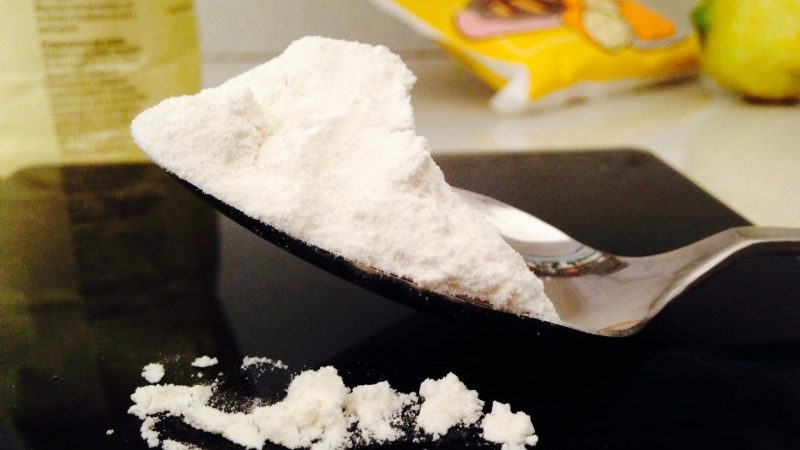Finding some tiny translucent bugs and mites inside your home can be very overwhelming, especially if you don’t know where they come from. Because they are too small, you can hardly identify them.
Although some of them might be harmless to humans, you should not touch them or disturb them right away.
So, what could be the small clear bugs in my house? The small clear white and mite bugs that can enter houses are mealybugs, woolly aphids, and whiteflies. They could also be some mite species, such as dust mites and grain mites. All of these microscopic pests may look similar to each other but they have different characteristics.
Most bugs and mites are usually found outdoors, especially in the garden. But in some cases, people unintentionally bring them inside their houses.
On the other hand, some of them are naturally indoors but are not easily noticeable. In this guide, you will learn some of these uninvited pests and how to get rid of them.
5 Small Clear White Bugs and Mites in the House
1. Mealybugs

Mealybugs are little white bugs that belong to the family Pseudococcidae. They are about 3 mm long, with soft oval bodies, and are usually covered with fluffy wax.
Adult females have no wings and look similar to nymphs, while the adult males, which rarely appear, have two tiny wings and two long tail filaments.
The four most common mealybug species are citrus mealybugs (Planococcus citri), longtailed mealybugs (Pseudococcus longispinus), pink hibiscus mealybug (Maconellicoccus hirsutus), and Madeira mealybugs (Phenacoccus madeirensis).
Mealybugs feed on various kinds of plants in the garden, landscape, and indoors.
Why Are Mealybugs in My House?
Most female mealybug species have a high reproductive capacity and are usually found in colonies sucking on plant sap and producing honeydew.
Although they cannot fly and crawl slowly, these clear bugs can enter your house and invade your indoor plants. Mealybugs are also attracted to warm weather and moisture.
Are Mealybugs Dangerous to Humans?
Mealybugs don’t bite and don’t carry diseases. However, although they are not dangerous to humans, these garden pests can transmit various viruses between plants.
A huge population of mealybugs can limit or slow plant growth, reduce fruit quality, and severely damage different ornamental plants, indoors and outdoors.
How to Get Rid of Mealybugs in Your Plants?
One female mealybug can lay more than 200 eggs in more or less 20 days, which is why infestation is always likely to happen. During favorable weather conditions, all life stages may be present during the entire year.
So before they become troublesome, here are some ways to get rid of mealybugs in your plants:
- Isolate infested plants from the rest to avoid further spreading.
- With smaller infestations, trim mealybugs out or handpick them using a cotton swab dipped in 10-25% isopropyl alcohol solution. Just make sure you don’t destroy the plant.
- Put natural predators of mealybugs in your plant. This includes lady beetles, spiders, and mealybug destroyers such as .
- Inspect new plants carefully before installing them or placing them indoors.
- Avoid unnecessary and too many applications of nitrogen fertilizer on your plants. High nitrogen levels stimulate mealybug egg production.
2. Woolly Aphids

Woolly aphids are sap-sucking insects that belong to the family Eriosomatinae. Their bodies are covered with white, fluffy wax that looks like wool.
They are about 2-4 mm long, with banded antennae and slightly darkened veins on the wings. Just like mealybugs, woolly aphids also produce honeydew on plants.
Among the most common species are woolly apple aphids (Eriosoma lanigerum) and woolly hackberry aphids (Shivaphis celti).
Generally speaking, woolly aphids have two host plants – one that they overwinter on and where they lay eggs, and another that they feed on during summer. These aphids usually feed in groups.
Why Are Woolly Aphids in My House?
Woolly aphids can enter your house through infested plants. The more indoor plants you have, the higher the possibility that you will encounter a woolly aphid infestation.
They can travel from one plant to another either by flying or crawling. Nevertheless, some of these small white bugs in houses don’t have wings.
Are Woolly Aphids Dangerous to Humans?
Just like all other aphid species, woolly aphids are harmless and are not dangerous to humans.
But although they don’t bite or sting, their feeding causes twisted and curled leaves, yellowed leaves, and poor plant growth. Fortunately, woolly aphids only affect the plant’s appearance but not necessarily their health.
How to Get Rid of Woolly Aphids in Your Plants?
As mentioned above, the presence of woolly aphids in plants should not be a major concern in terms of their health.
A woolly aphid infestation also seldom occurs, and using pesticides is not necessary. But because they are still nuisance pests, here are some effective ways to get rid of woolly aphids in your plants:
- Hose off honeydew that aphids have produced on the plants. This will discourage the growth of fungal plant disease or sooty mold.
- Reduce woolly aphid population by placing their natural enemies such as ladybugs, lacewings, and parasitic wasps.
- Spray soapy water on small trees. However, be careful not to kill the aphids’ natural enemies.
- To reduce potential aphid attacks on your garden, remove all the weeds and cover the beds with mulch.
- Neem oil such as Neem Organics Pure Neem Oil contains azadirachtin, which kills aphids by interfering with their normal life cycle.
3. Whiteflies

Whiteflies are about 1/10-1/16 inches long, with yellow bodies and four broad wings that are covered with a white wax coating.
But contrary to their name, they are not true flies. Instead, these tiny white bugs belong to the order Hemiptera (also called true bugs) and are closely related to mealybugs and aphids.
Just like mealybugs, whiteflies also suck out plant sap and excrete honeydew. They feed on the undersides of the leaves by punching holes with their needle-like mouthparts.
A whitefly infestation is only obvious once the leaves turn yellow or are dropping all of a sudden, and when adult whiteflies emerge from the plant.
Why Are Whiteflies in My House?
Whiteflies are mostly found outdoors, and they are not interested in entering your house. However, these small white bugs may be transported into your home through indoor plants.
But because they are under the leaves, you will hardly see them. Females lay 200-300 eggs, and nymphs can easily build up indoors.
Are Whiteflies Dangerous to Humans?
Whiteflies are not dangerous to humans. They neither bite nor carry diseases that can harm people and pets. But then, a significant population of whitefly nymphs can cause plant distortion.
They can also transmit diseases in plants and eventually cause very important damage to your indoor plants and garden.
How to Get Rid of Whiteflies in Your Plants?
Controlling heavy whitefly infestations is very challenging because they are tiny and are hiding under the leaves.
Nymphs are considerably greater in numbers than adults, which makes them even more difficult to see. Below are some useful tips to get rid of whiteflies in your plants, indoors and outdoors:
- Place odorless, non-toxic sticky traps for whiteflies such as Bugzilla Sticky Trap for Plant Indoor and Outdoor .
- Put naturally occurring parasites of flies such as spiders and lady beetles into your plants. For indoor plants, you can put Nature's Good Guys Encarsia Formosa Eggs for Whitefly Control .
- Avoid using pesticides that can harm your plants and kill their natural enemies.
- Inspect new plants thoroughly before bringing them indoors or into your garden.
- Inspect plants regularly, and remove heavily infested leaves to avoid further damage.
4. Dust mites
Also called house dust mites, dust mites are microscopic organisms that live in close association with dust in dwellings, hence the name. They are about 0.5 mm long, clear to creamy white, with a globular body.
These tiny, white mites are close relatives of chiggers, ticks, and spiders, and therefore, have eight legs.
The two most common dust mite species are American house dust mite (Dermatophagoides farinae) and European house dust mite (Dermatophagoides pteronyssinus).
Dust mites eat the dander (shed skin) of humans and are mostly found in beds, carpets, clothes, pillows, stuffed toys, and upholstered furniture.
Why are Dust Mites in my House?
Dust mites appear naturally in almost all houses, especially if there is lots of dust. But then, these very tiny creatures are more present when the weather is very warm and the humidity level is very high.
Dust mites also feed on animal dander, which means they populate more if you have pet dogs or cats at home.
Are Dust Mites Dangerous to Humans?
Dust mites don’t bite and don’t carry diseases but can still be dangerous to humans, especially those with asthma or who are allergic to dust.
Dust mite feces, secretions, and body fragments contain very powerful airborne allergens. Once the dust is disturbed, it can be inhaled and cause allergic reactions.
How to Get Rid of Dust Mites in Your Home?
You cannot see these dust mites, but there are signs of dust mite allergy, which includes frequent sneezing, coughing, and runny nose.
There is no single solution to eliminate them, but you can prevent severe infestation. While treating the patient, here are some ways to get rid of dust mites in your home:
- If possible, avoid having wall-to-wall carpeting. Otherwise, vacuum the carpet at least twice a week.
- Remove or relocate furniture where dust mites can easily accumulate.
- To kill the dust mites on bed sheets, blankets, and pillowcases, wash them in hot water, at about 130°F (54.4°C).
- If your child or any member of the household has asthma or is allergic to dust, don’t expose them to stuffed toys.
- Use beds with a wooden or metal frame instead of upholstered beds.
- Put your mattress and pillows in zippered, dust-proof covers. Among the best products are Microfiber Zippered Mattress Cover and Everlasting Comfort Waterproof Pillow Protectors .
- Dust mites are less likely to survive at a humidity level of below 50 percent. Improve the ventilation in your house and install a reliable dehumidifier such as Gocheer Upgraded Dehumidifier .
- To help remove allergens, install allergen-trapping air filters such as TOPPIN HEPA Air Purifiers .
Related: How Do You Get Rid of Little White Bugs That Look Like Dust? | Identification and Control Guide
5. Grain Mites

Also called flour mites, grain mites are about 1/50 inches long, with pearly or grayish-white soft bodies and eight legs that are pale yellow to reddish-brown.
Each of their legs has a claw, but their larvae have only six legs. Once larvae molt and grow into nymphs or juvenile grain mites, they will already have eight legs.
Grain mites feed on processed or finely ground grains, cheese, flour, pet food, powdered milk, wheat germ, yeast, and fungi food.
Once they populate their food, these wingless white mites will look like a moving layer of dust. Aside from homes, they can also be found in poultry houses and abandoned beehives.
Why are Grain Mites in my House?
Grain mites are very attracted to moisture and can enter your house if you buy infested food. These microscopic mites will hide in damp storage locations such as kitchens and pantries.
The first obvious sign of a grain mite infestation is the presence of “mite dust”, especially during hot, humid conditions.
Are Grain Mites Dangerous to Humans?
Grain mites don’t bite and don’t carry diseases, but exposure to a huge population can lead to grocer’s itch or allergic dermatitis. Nonetheless, grain mites are still not considered dangerous to humans.
But then, pets consuming heavily infested grain or pet food will result in diarrhea, reduced feed intake, and impaired growth.
How to Get Rid of Grain Mites in Your Home?
To start with, using pesticides is not advisable indoors, especially in kitchens and food storage areas.
Females can lay up to 600 eggs or more during favorable weather conditions, and heavy infestations are very difficult to control. If you want to get rid of grain mites inside your house, here are some things you should do:
- Throw away all infested grains and food products.
- Empty all storage bins and vacuum all inside and out.
- Also, vacuum the walls and floors in your storage area and make sure no grain mites are left behind.
- Wash the bins, walls, and floors with soapy water.
- Inspect the remaining grains thoroughly and place them inside tightly sealed containers.
- Inspect new grain packets carefully before buying them, and don’t buy damaged packages, as well as those stored in damp locations.
- To help prevent grain mites, maintain a moisture level of below 13% in your storage area.
List of Sources
Potter, M. F. (2000). House Dust Mites. University of Kentucky.
Frank, S., Baker, J. (2019). Mealybugs. NC State Extension.
Flint, M. L. (2015). Whiteflies. University of California Agriculture & Natural Resources.
Woolly Aphids. Bohart Museum of Entomology – University of California.
Jacobs, S. (2017). Flour and Grain Mites. PennState Extension.
- Bed Bug Surge 2025: How to Detect, Prevent, and Safely Eliminate Infestations in Top U.S. Cities - June 18, 2025
- Asian Needle Ants Invade US Homes: 2025 Guide to Identification, Risks, and Effective Control - June 11, 2025
- New World Screwworm Alert: How US Livestock Owners Can Prevent Outbreaks and Protect Herds [Summer 2025 Update] - June 8, 2025

